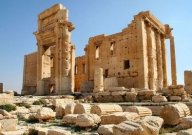Archaeology & History
July 24, 2012 · 28 comments
28 comments

Image Credit: CC 3.0 Zeledi
It seems that not only was the area host to extensive farming but that the engineers of the day had found a way to provide water to the city as well. It is thought that the city prospered up until around 700 AD after which time it had started to fall in to ruin.
Source: National Geographic | Comments (28)
How did Palmyra thrive in the desert ?
By T.K. RandallJuly 24, 2012 ·
 28 comments
28 comments
Image Credit: CC 3.0 Zeledi
With a population of 200,000, the Roman city of Palmyra prospered despite its location in the desert.
Now a crumbling ruin, the once prosperous city would have been a bustling trade hub and oasis in the middle of what was otherwise a dry, infertile desert. To learn more about what made Palmyra so successful, archaeologists have been studying the surrounding area using ground inspections and satellite images. What they found was an extensive series of farming villages within less than a day's walk of the city along with man-made reservoirs and channels laid out between them.It seems that not only was the area host to extensive farming but that the engineers of the day had found a way to provide water to the city as well. It is thought that the city prospered up until around 700 AD after which time it had started to fall in to ruin.
Today it's a mirage-like expanse of monumental ruins. But under the Roman Empire, Palmyra was a trading metropolis, according to historical and archaeological evidence.
Source: National Geographic | Comments (28)

The Unexplained Mysteries
Book of Weird News
AVAILABLE NOW
Take a walk on the weird side with this compilation of some of the weirdest stories ever to grace the pages of a newspaper.
Click here to learn more

Support us on Patreon
BONUS CONTENTFor less than the cost of a cup of coffee, you can gain access to a wide range of exclusive perks including our popular 'Lost Ghost Stories' series.
Click here to learn more
Ancient Mysteries and Alternative History
Palaeontology, Archaeology and History
Science and Technology
Earth, Natural Disasters and the Environment
Total Posts: 7,776,069 Topics: 325,420 Members: 203,874
Not a member yet ? Click here to join - registration is free and only takes a moment!
Not a member yet ? Click here to join - registration is free and only takes a moment!




























Please Login or Register to post a comment.